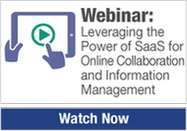 We’re on the Internet, and just about anything is capable of distracting us. And with all that oversaturation of content and products, there’s an oversaturation of features that are immediately appealing, but won’t provide much value in the long run. How many “industry leaders” are there? Who really provides the “best ROI”? What exactly makes something “world class”?
We’re on the Internet, and just about anything is capable of distracting us. And with all that oversaturation of content and products, there’s an oversaturation of features that are immediately appealing, but won’t provide much value in the long run. How many “industry leaders” are there? Who really provides the “best ROI”? What exactly makes something “world class”?
Document management systems are no different: most services will throw out buzzwords to trigger your survival instincts and reel you in and get you invested in a product that doesn’t provide you with what you really need – for all you know, you might not even need document management!
These are generalities, but my most successful clients that implement DMS are focused on optimizing workflow, records retention, dealing with an incredibly high volume of time-sensitive documents, and security. If you're looking to buy document management services, and a prospective SaaS vendor offers any of these features, take a step back and reevaluate how they align with your priorities
Lowest Price
This is a tough lesson to learn. We all want to get a good deal when we buy something. Unfortunately, we’ve been brainwashed to believe that the lowest price means we are getting the best deal. Low Purchase Price ≠ Best Value. When purchasing a technology solution, you have to look at more than just the purchase price. That is only the beginning.
If you are going to utilize the application, especially a long-term application such as a document management system, you have to look at the Total Cost of Ownership (TCO) to find the best value. TCO includes the following at a minimum:
- Purchase price
- Annual maintenance
- Software updates
- Hardware updates
- Support personnel
By looking at the total cost of ownership, you see the hidden costs that don’t show up in the purchase price. Determining the best value depends on your situation. With license-based or on-premise document management systems, you have to take into account:
- How much time does it take to set up?
- How many servers do you need?
- How much storage and back up do you need?
- How many people-hours will it take to keep it running/perform updates and upgrades?
When you factor all of these into the equation, it becomes clear that the value is based on more than the initial purchase price. Make sure that you include all costs when comparing document management prices, not just the price you see up front.
“Best of Breed” and Other Labels
I have heard many of the big integrators and even some of the smaller ones talk about their solutions being made up of the “Best of Breed” components. What they’re really saying: they took a bunch of parts and painted them all the same color and called it an integrated system. It may work well for you, but you also may find that it is just too complex to keep your solution running.
In most situations that I have seen, the customer does not really need the “Best”. They just need something that works and provides them a reasonable return on their investment. Since document management and workflow are typically complex solutions, how do you really define the best? Cheapest? Most expensive? Most sales? Prettiest brochures? Best scanning? Best Workflow?
The best approach is to define the problem you are trying to solve and then find the solution that you can afford that solves that problem. You will never use all of the bells and whistles that come with the best of breed. You are running a business, not a fashion show.
Know Yourself, Know Your Worth
Ultimately, you have to start by assessing the value of your organization as it stands: would I be my own customer? If you know what keeps you from answering “yes”, you’ll know the solution. When you know the solution, the services that aren’t truly for you will naturally weed themselves out. You’ll know how much you’re willing to invest and the long-term returns. You’ll know what to look for in an electronic document management platform. You’ll understand what “best” really means to you.
As long as your workflow is consistent, your files are in the right place for the right amount of time, and your most sensitive information is protected, you’re in better shape than most people who haven’t implemented DMS…and a lot of people who have implemented it without looking out for the red flags.

